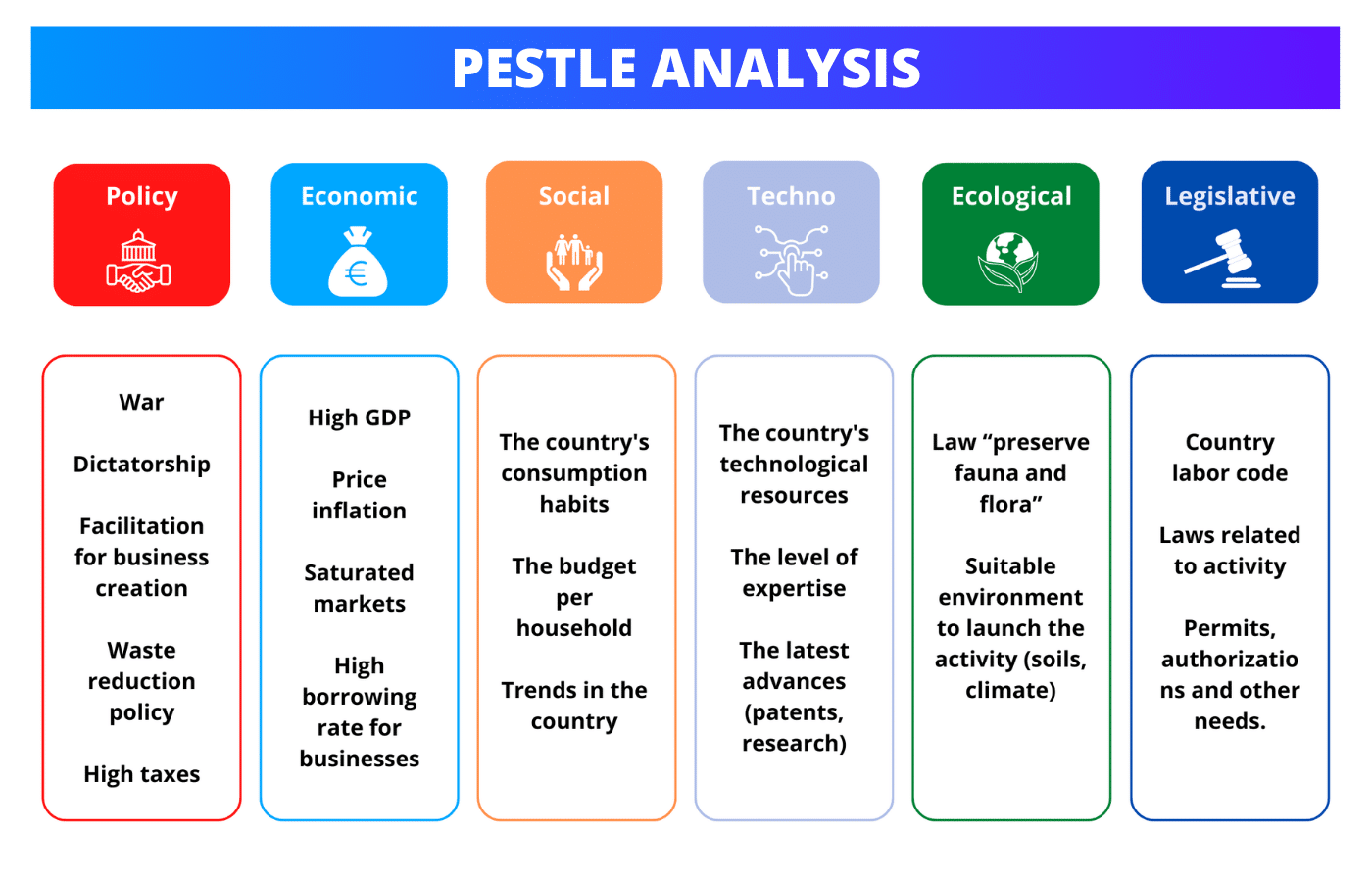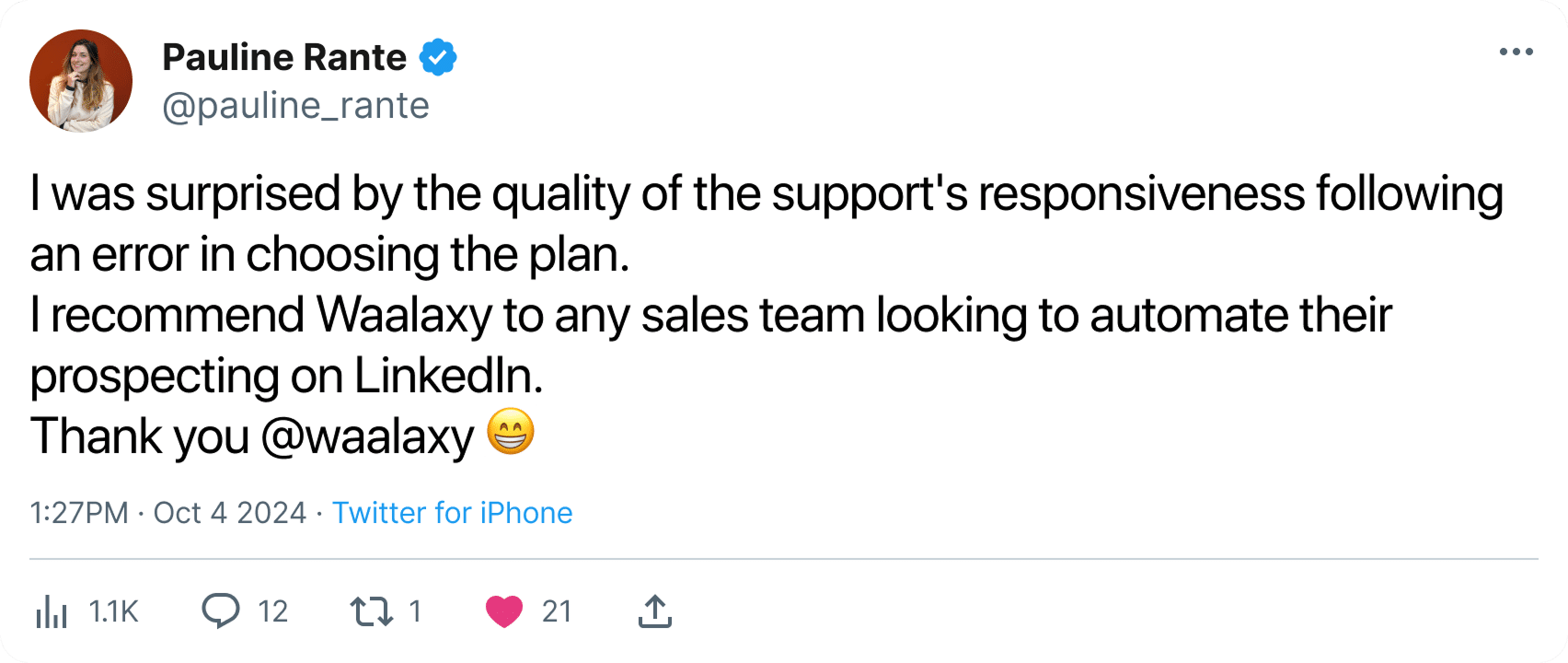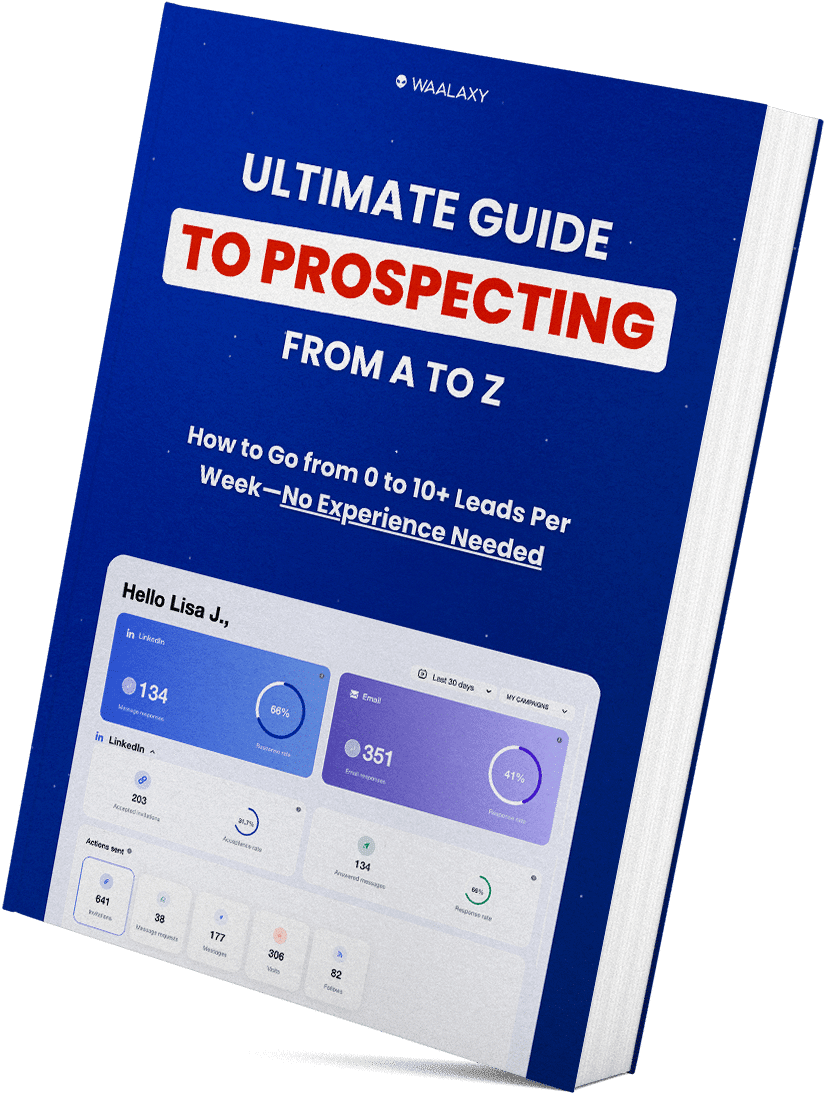What is PESTLE analysis? Also known as the PESTLE chart or macro environment PESTLE matrix, is a strategic tool that helps companies assess external factors that may impact their operations and growth. 🌱
🚀 By using this analysis:
- You can quickly determine if a market is promising, 🔎
- And/or identify any potential obstacles that may require an action plan to ensure your project’s success. 👀
🥇 When to do a PESTEL analysis? It should be the first step you take to understand the market before launching your business.

Before we dive into how to conduct a PESTLE analysis with PESTLE analysis example, let’s first explore what this method is for and why it’s essential. 🤗
What is PESTLE Analysis Used for? Definition & Why To Use It
PESTLE analysis is a marketing strategy and macro-environmental analysis tool that helps you understand the broader market dynamics (like the overall economy in a country such as France).
By monitoring market opportunities and threats, a company can anticipate changes in the PESTLE environment and ensure the sustainability of its operations.
For instance, if an established company wants to diversify its business and develop a new tool, it needs to analyze the market from all angles using PESTLE. This helps ensure that barriers to entry aren’t insurmountable and that the market is favorable for launching the new tool. 👀
There are 6 key external pestel factors in PESTLE analysis, which form the acronym:
1️⃣ Political.
2️⃣ Economic.
3️⃣ Sociological.
4️⃣ Technological.
5️⃣ Legal.
6️⃣ Environmental.
To illustrate, here’s what you might analyze in each category:

Need further information on how to nail your PESTLE analysis and market research? Stick with us—it’s coming soon! 🚀
How to Conduct a PESTLE Analysis?
Ready to create a solid PESTLE analysis? We’ve got you covered. First, we’ll provide you with several PESTEL analysis examples to follow, and next we’ll break down the method with six criteria in detail. 🤩
PESTLE Analysis Examples
To REALLY help you conduct a PESTLE analysis, we’ve analyzed two major companies that will serve as examples: Nike and Apple. 🤗
Nike PESTLE Analysis Example

Nike is a multinational company specializing in the design, manufacture, and marketing of sportswear, footwear, and equipment. ⚽️
The brand is globally recognized for its innovation and influence in the sports and fashion industries.
👔 Political:
- Strict regulations on working conditions in countries where production is outsourced.
- Geopolitical tensions and trade restrictions, particularly between the U.S. and China, impacting tariffs, production costs, and trade profit margins.
- Increasing regulations to adopt more sustainable practices, affecting supply chain management.
🤑 Economic:
- Global exchange rate fluctuations impacting net revenues.
- Economic recessions and fluctuations, reducing consumer spending on non-essential products like sportswear.
- Inflation and rising raw material costs, which can affect profitability.
🗣️ Social:
- Growing demand for corporate social responsibility from international companies.
- Rising wellness and health culture, with a focus on fitness and personal well-being, driving demand.
- Increasingly young populations in emerging markets, presenting new growth opportunities.
⚙️ Technology:
- Continuous innovation and integration of new technologies to stay competitive.
- Investments in digital transformation and technologies to enhance customer experience and optimize the supply chain.
- Significant investments in customer data security.
⚖️ Legal:
- Protecting innovations through intellectual property rights to combat counterfeiting.
- Ongoing legal disputes related to commercial practices and contracts with athletes or influencers.
- Compliance with international safety standards to avoid product recalls and fines.
🌱 Environment:
- Pressure from consumers and regulators to reduce carbon footprints and use sustainable materials.
- Waste management challenges related to production and product life cycles.
- The impact of climate conditions on raw materials like cotton, which can affect production.
This PESTLE analysis highlights that Nike must navigate a constantly evolving global market, where adaptability is crucial to maintaining and strengthening its leadership position.
Apple PESTLE Analysis Example

Apple is a multinational company specializing in the design, manufacture, and sale of consumer electronics, computer software, and online services.
👔 Political:
- Strict regulations on data protection and privacy, such as GDPR and CCPA.
- Geopolitical and trade tensions, especially between the U.S. and China, threatening the supply chain and increasing production costs.
- Growing pressure for global tax reform, challenging the company’s tax optimization practices and those of its subsidiaries.
🤑 Economic:
- Fluctuations in exchange rates that could impact international revenues. 🚨
- Global economic conditions influencing consumer spending.
- Increased competition in a saturated technology market, potentially affecting market share and pricing.
- A global economic slowdown could reduce demand for high-end products.
🗣️ Social:
- Shifting consumer habits toward more socially responsible and sustainable practices.
- The growing importance of integrating social networks and health technologies into electronic products. 🚀
- An aging population in certain key markets, which may influence demand.
- Increasing societal pressure for diversity and inclusion in corporate practices.
⚙️ Technology:
- Rapidly evolving technologies that demand constant innovation.
- Increasing security threats, highlighting the need for enhanced cybersecurity. 🛡️
- The development of artificial intelligence and machine learning as key competitive advantages.
⚖️ Legal:
- Patent laws and intellectual property issues impacting new product development.
- Regulations concerning electronic safety standards. 🤖
- Ongoing litigation that could have financial and reputational consequences.
🌱 Environmental:
- Pressure to reduce the carbon footprint and enhance product sustainability.
- The management and recycling of electronic waste.
- The use of renewable and non-toxic materials in manufacturing and production.
This PESTLE analysis indicates that Apple must navigate a complex and rapidly changing environment to maintain its position as a market leader.
⏰ Now, it’s time to explain PESTLE analysis method to exactly know how to do your PESTLE analysis.
PESTLE Analysis Example & The 6 Key Factors
To conduct a PESTLE analysis, you’ll need to create a chart where you fill in information across the 6 key factors of the model (as mentioned earlier), tailored to the market you’re analyzing.
To make this easier, here’s an example of PESTLE analysis chart that you can copy, paste, and fill in with your data (using bulleted lists, for example). 👇🏼
| PESTEL Analysis Examples | Opportunities | Threatens |
| Political | ||
| Economic | ||
| Social | ||
| Technological | ||
| Legal | ||
| Ecological |
We recommend adding two additional columns to your PESTLE chart : Opportunities and Threats. These will help you quickly identify the necessary actions following your company’s external analysis.
If you want to take your analysis even further, consider combining your PESTLE chart with other techniques, depending on the depth of analysis you need:
- Meso Environment with Porter’s 5 Forces: Analyze the competitive market you’re looking to enter.
- Micro Environment with Internal Analysis: Evaluate the strengths and weaknesses of your company’s resources to better meet market demands.
- Global Synthesis with SWOT Analysis: Compare strengths and weaknesses alongside opportunities and threats to identify areas for improvement and differentiation.
In our opinion, the most effective approach is to combine macroeconomic analysis with mesoeconomic (or competitive) analysis of external factors.
See this other PESTLE framework chart below for a copy-and-paste template. 👇
| PESTLE (Macro) | Porter’s 5 forces (Meso) | ||||||
| Political | Potential new market entrants | ||||||
| Economic | Customer strength | ||||||
| Social | Threat of substitutes | ||||||
| Technological | Supplier strength | ||||||
| Legal | Rivalry of competitors | ||||||
| Ecological | |||||||
🎁 Interested? We’ve compiled all our PESTLE analysis templates into one convenient file for you to reuse. 🔗 Grab it here : pdf PESTLE analysis example.
Finally, it’s time to break down the six criteria in detail to exactly know which information to put in your chart. 👇🏼
PESTLE Political Factors Example
In this section, we’ll gather all the governmental and institutional decisions that could directly or indirectly impact the market you’re looking to enter:
- Government-Business Relationship: How the government interacts with and influences businesses. 🤝
- Governmental Stability: The stability of the local, regional, or state government.
- Regulatory Constraints: Existing regulations that could affect your operations.
- Tax Conditions: State-imposed tax rates that might influence your choice of legal status, whether as a company or a self-employed entrepreneur.
- Geopolitical Conflicts or Tensions: Any conflicts or tensions between states that could impact your market.
- International or European Organizations: Bodies that regulate markets on an international level.
The state of these factors will significantly impact your company’s operations and the strategic decisions you’ll need to make.
For Example:
👉🏼 Coca-Cola temporarily left Russia during the war in Ukraine.
👉🏼 The corporate tax rate in France is 10% higher than in Poland.
Considering all these factors, you might want to think carefully about which country and market to develop your project in. 😉
PESTLE Economic Factors Example
💸 Economic analysis involves assessing the economic climate and external financial factors that dominate or influence the market in which your company operates:
- Market Growth: For example, using statistics from sources like the U.S. Census Bureau or other relevant data. 📈
- Inflation, Taxation, and Interest Rates: Especially important for companies that frequently borrow.
- Monetary Stability and Exchange Rates: Fluctuations can significantly impact financial outcomes.
- Labor Costs: Affecting competitiveness through production costs, etc.
- Disposable Income (KPI) : An indicator of consumer purchasing power within a country.
- Cost of Raw Materials: The price of key resources directly related to your business activity.
For Example:
👉🏼 The price of gasoline and natural gas, which doubled in several countries following the COVID-19 crisis.
👉🏼 The volatility of the euro-dollar exchange rate over a specific period. 💰
In summary, analyzing these criteria will give you a clear picture of the market’s overall “health.”
PESTLE Social Factors Example
Sociocultural analysis involves studying the demographics and behaviors of a population to understand how they influence the market: 👀
- Age and Demographic Trends: Including birth rates, age distribution, and overall population health. 📈
- Socio-professional Categories: Dominant and minority groups, urban-rural divide, etc. 🎓
- Gender Distribution: For instance, if there are significantly more men than women in a given area. 🦋
- Social Equality and Diversity: The distribution of roles and income, and levels of tolerance towards minorities. 🌈
- Consumer Habits and Trends: Lifestyles, consumer behavior, and the time and money people allocate to leisure, sports, and other activities. 🥤
For Example:
👉🏼 Consumer expectations are constantly evolving, often reshaping market dynamics.
👉🏼 Since 2022, American consumer trends have increasingly emphasized values such as inclusivity, sustainability, and social responsibility. U.S. consumers are not only looking for transparency and ethical practices in the brands they support but are also increasingly focused on companies’ commitments to diversity and environmental stewardship.
As a next step, you’ll want to conduct a microeconomic analysis (within your business) to further refine your insights and be able to 🔬:
- Segment your market(s),
- Identify specific population groups,
- And ultimately, create your buyer persona.
PESTLE Technological Factors Examples
In this part of the analysis, the focus is on technological capabilities and resources available in the market: 👇🏼
- Monitoring New Product Launches: Keep an eye on digital innovations, technology trends and key market events.
- Research Funding: Consider the level of investment in R&D, both private and public.
- Access to Technology: Evaluate the availability of tools like high-speed internet (5G), information systems, and advanced machinery. 📲
- Patent Presence: Patents can significantly impact a company’s operations and market position.
- Integration of Automation and AI: Assess the potential for incorporating automation, artificial intelligence, and communication channels into the business (which is continuously expanding).
For Example:
👉🏼 The United States enjoys advanced resources and technologies that are ahead of those in many other countries.
👉🏼 For instance, IT educational institutions in the U.S. are often better equipped than their counterparts elsewhere.
These factors are crucial and should be identified within the broader market context, as they can significantly influence how a project is approached and even determine its feasibility.
PESTLE Legal Factors Example
⚖️ The final factor to analyze is the legal landscape: the country’s laws and employment regulations that directly influence a company’s operations and growth:
- Industry-Specific Regulations: Laws related to the activity, sector, or marketing of certain products/services.
- Consumer Protection: The level of protection and rights afforded to consumers.
- Labor Law and Safety: The level of protection, safety standards, and employment regulations. 🛡️
- Contract and Customs Law: Regulations governing contracts and international trade.
👉🏼 In USA, the Law “Pregnant Workers Fairness Act” (PWFA), has been in effect since June 2023. This law requires employers to provide reasonable accommodations for employees who are pregnant or have conditions related to pregnancy. It also imposes restrictions on how employers can treat these employees, thereby strengthening workplace protections.
In conclusion, these laws can impact the general workforce but may also be highly specific depending on the market you plan to enter. 📍
PESTLE Environmental Factors Example
This part of the analysis focuses on ecological considerations related to your business activities and efforts to meet environmental standards: 🍃
- Laws Promoting Sustainability: Regulations that encourage environmental protection and sustainability practices.
- Market or Industry Trends: Trends related to specific products, markets, or industries that are influenced by ecological concerns.
- Commitment to Protecting Nature: The growing interest in safeguarding the environment and ensuring a better future for the next generations. 🌍
- Impact of Transportation: Consideration of how different modes of transport affect the environment.
- Support for Clean Energy: The level of investment and support for renewable energy sources and industries.
👉🏼 In 2024, the Securities and Exchange Commission (SEC) plans to finalize new rules requiring companies to disclose more information about climate risks and greenhouse gas emissions, thereby strengthening reporting obligations for public companies.
That’s it—I believe you now know exactly which information is relevant and should be included in your PESTLE analysis!
Conclusion: What To Do After Your PESTLE Analysis?
Once the PESTLE analysis has been carried out, it’s essential for your company to transform the information gathered into concrete strategic actions. 💥
The steps are fairly simple to remember 👇🏼 :
- First, analyze the market in its broadest sense (Macro), then in increasingly close proximity (Meso) and finally internally (Micro).
- Also analyze market opportunities and threats, then the strengths needed to meet consumer needs (especially in the case of a SaaS company),
- Identify potential obstacles and weaknesses.
- Adopt CRM tools and other complementary analysis techniques, to detect other elements with an impact on the business.
- Adapt business strategy, building on strengths and reducing weaknesses.
Last but not least, PESTEL analysis is indispensable, but it is a model with its own limitations, which should be avoided and are discussed in the FAQ. 😉
Frequently Asked Questions (FAQ)
What Are The Limitations of PESTLE Analysis?
❌ As mentioned in the article, PESTLE analysis has its limitations, particularly in its inability to account for certain factors:
- Internal capabilities,
- Competition and substitute products,
- Business plan considerations,
- Organizational or business weaknesses,
- Interactions between factors with combined or interdependent effects,
- …
The PESTLE model analysis is therefore insufficient if used alone to fully understand all the elements that may impact your business. 😔
What Tools Can Be Used To Complement PESTLE Analysis?
✅ To address the limitations of PESTLE analysis, it should not be used in isolation. Instead, it should be integrated into a broader strategic approach and complemented by other tools to refine your analysis.
⚙️ The following tools can be used alongside PESTLE analysis:
- SWOT Analysis: (Strengths, Weaknesses, Opportunities, Threats).
- Porter’s 5 Forces.
- Value Chain Analysis.
- 4P Marketing Mix: (Product, Price, Place, Promotion).
- Business Plan and Product Life Cycle.
- Segmentation, Targeting, and Positioning (STP).
However, it’s important to regularly update these tools to keep them relevant, especially given the rapid evolution and changes in the factors involved. 🔄
What’s The Difference Between SWOT & PESTLE Analysis?
SWOT analysis assesses internal strengths and weaknesses, as well as external opportunities and threats specific to an organization. 👀
On the other hand, PESTLE analysis focuses on the detailed external factors—political, economic, socio-cultural, technological, environmental, and legal—that influence the broader context in which the organization operates. 🌍
👉🏼 In short, SWOT is more company-focused, while PESTLE is environment-focused. However, the two analyses are complementary and work well together for positioning and strategic decision-making. 🎯
And that’s the end of this article! Now you know exactly what PESTLE analysis is and how to do it right with our PESTLE analysis example! See you soon! 👽












